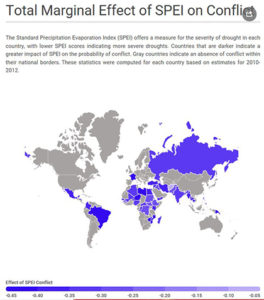New study establishes link between climate change, conflict and migration
A ground-breaking new study has produced the first provable link between climate change, conflict and international migration.
The study by researchers at the University of East Anglia, in the UK, is the first to provide an empirically established causal path from climate change to conflict to cross-border migration.
The study analyses data from 157 countries between 2006 and 2015 and provides strong evidence of particular areas and times where a causal relationship between climate change, conflict, and migration across the world had a profound impact.
In one case study, the report’s authors argue that in the countries affected by the Arab Spring between 2010 and 2012 there were climatic extreme conditions and severe drought which raised the likelihood of armed conflict to be a statistically significant explanatory factor of asylum-seeking.
“We can say the effect of climate change on migration is causal, and it operates through conflict,” said Raya Muttarak, one of the report’s authors.
Despite the lack of robust empirical evidence, a growing number of media reports attempt to link climate change to the ongoing violent conflicts in Syria and other parts of the world, as well as to the migration crisis in Europe.
Exploiting bilateral data on asylum seeking applications for 157 countries over the period 2006–2015, we assess the determinants of refugee flows using a gravity model which accounts for endogenous selection in order to examine the causal link between climate, conflict and forced migration.
“Our results indicate that climatic conditions, by affecting drought severity and the likelihood of armed conflict, played a significant role as an explanatory factor for asylum seeking in the period 2011–2015,” the report said.
The effect of climate on conflict occurrence is particularly relevant for countries in Western Asia in the period 2010–2012 during when many countries were undergoing political transformation.
This finding suggests that the impact of climate on conflict and asylum seeking flows is limited to specific time period and contexts.
“Our model supports the case for causal linkages for the period 2010–2012, where global refugee flow dynamics were dominated by asylum seekers originating from Syria and countries affected by the Arab spring, as well as flows related to war episodes in Sub-Saharan Africa,” the report said.
“Excluding these regions from the analysis provides further statistical evidence, that the link between climate shocks, conflict and subsequent migration flows might rather be interpreted as a local phenomenon and therefore very specific to these regions,” it said.
“Indeed, our study shows that an increase in drought episodes can drive outmigration through exacerbating conflict in a country with some level of democracy.
“Climate change thus will not generate asylum seeking everywhere but likely in a country undergoing political transformation where conflict represents a form of population discontent towards inefficient response of the government to climate impacts,” the report said.
The researchers said improving the adaptive capacity to deal with the effects of climate change in developing economies may have additional returns by reducing the likelihood of conflict and thus forced migration out-flows.
“From a policy point of views, our empirical analysis provides backing to some of the arguments for conceptualising global responses to climate change also in the framework of national security considerations and human security concerns,” they said.
“The integration of concerns related to conflict-driven forced migration in the current policy discourse concerning actions to combat climate change appears particularly urgent in the context of the targets defined by the Sustainable Development Goals (SDGs).
“The link between climate change and migration is not made explicit in the SDGs, which focus on adaptation measures and do not treat forced migration and climate change as interrelated phenomena which may be moderated by conflict on set.
“The results presented provide empirical backing to the connection of these two policy goals in the design of climate change responses at the global level, the researchers said.
Laurie Nowell
AMES Australia Senior Journalist












